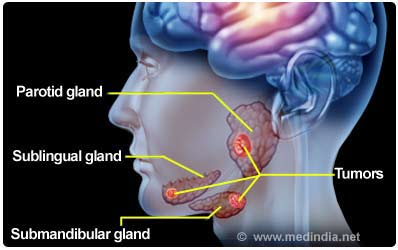- Sabiston Textbook of Surgery, 18th Ed.
- Schwartz Manual of Surgery, 8th Ed.
- Mayo Clinic
- National Cancer Institute
About
The formation of malignant (cancer) cells in the tissues of the salivary glands lead to a rare cancer called salivary gland cancer.
Salivary glands are the organs that make saliva and release it into the mouth. Enzymes present in saliva help digest food. The secretion is also rich with antibodies that help protect against infections of the mouth and throat. The salivary glands are classified as major and minor.
The three pairs of major salivary glands are Parotid glands, Sublingual glands and Submandibular glands.
Parotid glands are the largest among these and are found in front of and just below each ear. Sublingual glands are found under the tongue in the floor of the mouth. Submandibular glands are found below the jawbone. Apart from the three pairs of major salivary glands there are hundreds of small (minor) salivary glands.

Symptom & Signs: Most salivary gland tumors are not dangerous to health (i.e. benign) and occur in the parotid glands. The most common sign of a salivary gland tumour is a painless salivary mass or a newly noticed lump on the side of the face or below the jawbone. . Sometimes there maybe difficulty in swallowing
Diagnosis: It is evaluated by a technique called fine-needle aspiration biopsy. CT scans and MRI usually aid in detailed workup.
Treatment: Malignant tumours that pose danger to health usually need surgical excision and radiation.
Prognosis: This depends upon the grade of the cancer. Higher grade have a poorer outcome.








